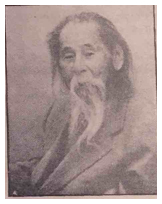Chuzo Tamotzu, Children’s Drawings, and the Art of Resolution
Chuzo Tamotzu and the Art of Resolution
 In 1920, Chuzo Tamotzu (1888–1975), who was born in Toguchi on the Japanese island of Amami Oshima, settled in New York after a multi-year international journey to study art. Over the next twenty years, he established himself not only as a figure in American avant-garde art, but also as an individual dedicated to supporting the political interests of his adopted homeland, as reflected not only in his participation in the Federal Art Project and Works Project Administration, but also through his service to the U.S. Army during World War II, when he volunteered as a combat artist. When the war ended, Chuzo Tamotzu married Louise Kates Tamotzu and moved from New York to Santa Fe, New Mexico. It was there that Chuzo, keenly aware of the importance of creating new bridges between the United States and Japan, conceived the idea of an art exchange between the children of Santa Fe and Hiroshima. From his perspective, children had the unique ability to see the world with eyes unclouded by political conflict.
In 1920, Chuzo Tamotzu (1888–1975), who was born in Toguchi on the Japanese island of Amami Oshima, settled in New York after a multi-year international journey to study art. Over the next twenty years, he established himself not only as a figure in American avant-garde art, but also as an individual dedicated to supporting the political interests of his adopted homeland, as reflected not only in his participation in the Federal Art Project and Works Project Administration, but also through his service to the U.S. Army during World War II, when he volunteered as a combat artist. When the war ended, Chuzo Tamotzu married Louise Kates Tamotzu and moved from New York to Santa Fe, New Mexico. It was there that Chuzo, keenly aware of the importance of creating new bridges between the United States and Japan, conceived the idea of an art exchange between the children of Santa Fe and Hiroshima. From his perspective, children had the unique ability to see the world with eyes unclouded by political conflict.
Working with Susan B. Anderson, the Director of Art Education for Santa Fe city schools, Chuzo composed a letter to the mayor of Hiroshima. Soon enough, a return letter arrived with a front page clipping of the Hiroshima Daily News. The headline read “Children Tie the World Together,” and it spoke to the overwhelming joy felt by Hiroshima at this offer of friendship and reconciliation. When the drawings themselves arrived from Hiroshima, transported by his friend Iwao Yonemoto, Chuzo personally helped coordinate an exhibition of these children’s drawings at the Museum of New Mexico as well as at several other locations in the southwest. Today, Chuzo’s work has been collected by museums and private individuals in the United States and Japan. But among his most important achievements, as he and Louise recognized, was to create a foundation for interaction for future generations through the drawings he brought together from children capable not only of recording but also of reimaging their world. Chuzo Tamotzu’s enduring values of compassion and peaceful understanding among individuals and nations remain vividly apparent through the works of art he inspired and in the lives that he touched.


 Museum of Art
Museum of Art